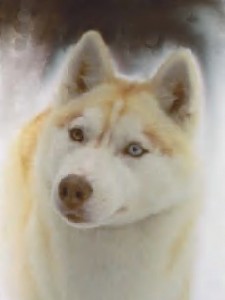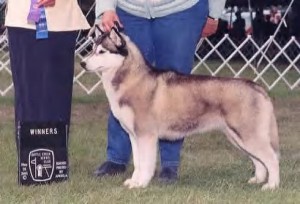Hi folks,
Off and on, over the years, we’ve encountered Siberians with hereditary cataracts. To be considered hereditary by CERF (Canine Eye Registry Foundation), there are certain criteria that the cataracts must meet when it comes to our specific breed. Recently, we encountered our first case of Corneal Dystrophy on a 4 year old bitch (previously clear every year). The only other time I’d heard of it was with a former friend who was able to end up with a clear diagnosis after changing the diet of her dog in question, and in a dog I’d co-bred with that same breeder, who was also able to correct it with a change of food. There are, apparently, 5 types of CD, all considered ‘hereditary’, but with 4 & 5 being the ‘bad’ ones. We were told by the vet that confirmed her initial diagnosis for us that because it was type 3, that we could use ‘breeders discretion’ and breed her, especially since we had data to suggest it wasn’t an issue in the line. He did not feel that food-type would have an impact on her case. We opted to have her spayed and put in a great pet home…. but we do have a dog who has a non-hereditary cataract and has been cleared by CERF, that I don’t feel should be pet-homed. That’s a tough pill for some breeders to swallow, because they aren’t clear on the difference between hereditary and non-hereditary defects.
So – If you’ve had any experience with eye defects, I’d love to hear more information.
Below is some additional information about some eye defects in Siberians. I should probably include Glaucoma – even though I’ve only ever heard of a handful of cases over the years, but for now, we could focus on these three…
Eye diseases are common in Siberians. The three most frequently diagnosed eye defects are Cataracts, Progressive Retinal Atrophy (PRA), and Corneal Dystrophy. To my knowledge, research has yet to produce information verifying the mode of genetic inheritance for each, and in some cases they may be environmentally influenced. However, they are still of great concern to reputable breeders. Many backyard breeders are unaware that their dogs are affected because there are no apparent signs that the diseases are present. They usually have to be diagnosed by a Canine Ophthalmologist.
Corneal Dystrophy: This condition affects the cornea of the eye. A cloudy ring will develop around the center of the eye. It usually shows up between 7 months and 3 years of age.
Hereditary Cataracts: Cataracts are the most common eye problem for the breed. The lens of the eye becomes ‘cloudy’. It will usually show up between 9 months and 2 years of age. In some cases, if serious, cataracts can be progressive and ultimately cause blindness, but typically, you would be otherwise unaware of the defect.
Progressive Retinal Atrophy (PRA): Progressive retinal atrophy is characterized by deterioration of the retina. It can cause blindness, dilation of the pupil, loss of visual cells, and other retinal abnormalities. It is passed along through autosomal recessive modes of inheritance
Insight welcome!

